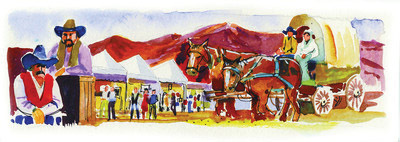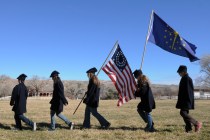Colder temperatures mean it’s a perfect time to visit Death Valley park
The Death Valley 49ers Days annually ushers in the peak visitation season in Death Valley National Park. Winding up today, this early November celebration draws hundreds of visitors, filing campgrounds, restaurants, park hostelries and accommodations in surrounding communities. As scores of recreational vehicles and other transportation depart following the festivities, regular visitors find park facilities back to normal and far less crowded.
The 49ers organization started the celebration nearly 60 years ago to keep alive the Old West traditions that color Death Valley's past and enhance its appeal. The group takes its name from the suffering trains of gold seekers crossing Death Valley by wagon, horseback and on foot as they headed for the California Gold Rush in 1849. Participants get a head start on 49ers Days by making arrangements months in advance to register for special events. Check with the group's Web site at www.deathvalley 49ers.org.
Death Valley's visitation runs counter to most national parks. As winter's cold slows the pace elsewhere in the park system, Death Valley comes into its own. Temperate autumns give way to short, mild winters, followed by long, pleasant springs. Because of blistering summers, the park used to nearly close down, but visitor pressure, especially from Europeans drawn to desert areas, dictated that the park remain open year-round. Most American visitors, however, continue to make Death Valley a cool season destination.
Southern Nevadans easily access Death Valley National Park by a number of different routes. Using U.S. 95, visitors reach the park through Lathrop Wells, Beatty or Scotty's Junction. Highway 160 over Mountain Springs to Pahrump provides access through Shoshone or Death Valley Junction. The shortest route follows Highway 160 through Pahrump north to Bel Vista Road, skirting Ash Meadows National Wildlife Refuge to reach Death Valley Junction.
Whichever approach you choose, impressive desert scenery awaits you. Rugged mountains facing each other across vast valleys dictate the direction of highways. Sparse vegetation, barren in winter, awaits enough moisture to trigger one of the desert's infrequent wonders -- a spring glorious with blooming wildflowers. Death Valley itself seems stripped naked, down to the bare bones of spiny mountain ridges, deep canyons and fans of rock spilling out to reach vast expanses of dry lakes on the valley floor.
One of the nation's largest national parks, dramatic and compelling Death Valley often daunts and dwarfs its visitors. It seems quite civilized where developed facilities cluster, as at Furnace Creek, Stovepipe Wells, Scotty's Castle and Panamint Springs. Attractions there include hotel and motel rooms, restaurants, gift shops, campgrounds, visitor centers, museums and service stations. Visitors golf, swim, play tennis, ride horseback, take scenic tours and join rangers for walks and programs. Some of the best trails, viewpoints and points of historic interest lie within easy reach of these installations.
However, most of the park remains undeveloped, untouched and definitely not civilized. It appeals to visitors seeking solitude in challenging desert and mountain terrain. Adventurous visitors hike lesser-known trails, explore lonely back roads and camp in the park's smaller, more primitive campsites.
Visitors lured by the park's remote regions should heed common sense rules. When you pay the $20 park entrance fee, check with rangers for necessary back country permits. Obtain a good, detailed map of the region, such as the one put out by AAA that the park service itself displays. Let rangers or other responsible persons know where you are headed and when you will return.
Even though service may be spotty, carry a cell phone and charger. Carry at least a gallon of water per person per day. Pack nutritious trail snacks and camp rations. Dress in warm layers, including a hat. Use sun block. Wear sturdy, comfortable footgear. Such simple steps and sensible preparations help you enjoy your outdoor adventures enough to plan return visits to explore more of Death Valley National Park.
Margo Bartlett Pesek's column appears Sundays.






















